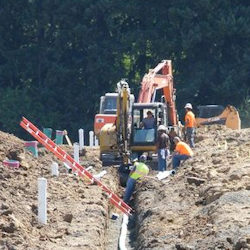Jobsite Safety
One of the most important responsibilities of field and office management is planning for safety. Most on-the-job problems and accidents directly result from improper planning. Correcting mistakes in shoring and/or shoring after work has started slows down the operation, adds to the cost and increases the possibility of an excavation failure.
Contractors should develop safety checklists to make certain there is enough information about the jobsite and all needed items, such as safety equipment, are on hand.
To help ensure safety in trenching and excavation operations before the start of trenching or excavation, the contractor will need to take these specific conditions into account:
- Soil types and layers
- Traffic
- Nearness of structures and their condition
- Surface and ground water conditions
- The water table evaluation
- Overhead and underground utilities (check with utility companies)
- Weather
These and other conditions can be determined by jobsite studies, observations and consultations with local officials and utility companies.
Knowledge Check Choose the best answer for the question.
6-1. The contractor must always contact the utility companies involved and inform them of the work _____.
You forgot to answer the question!

